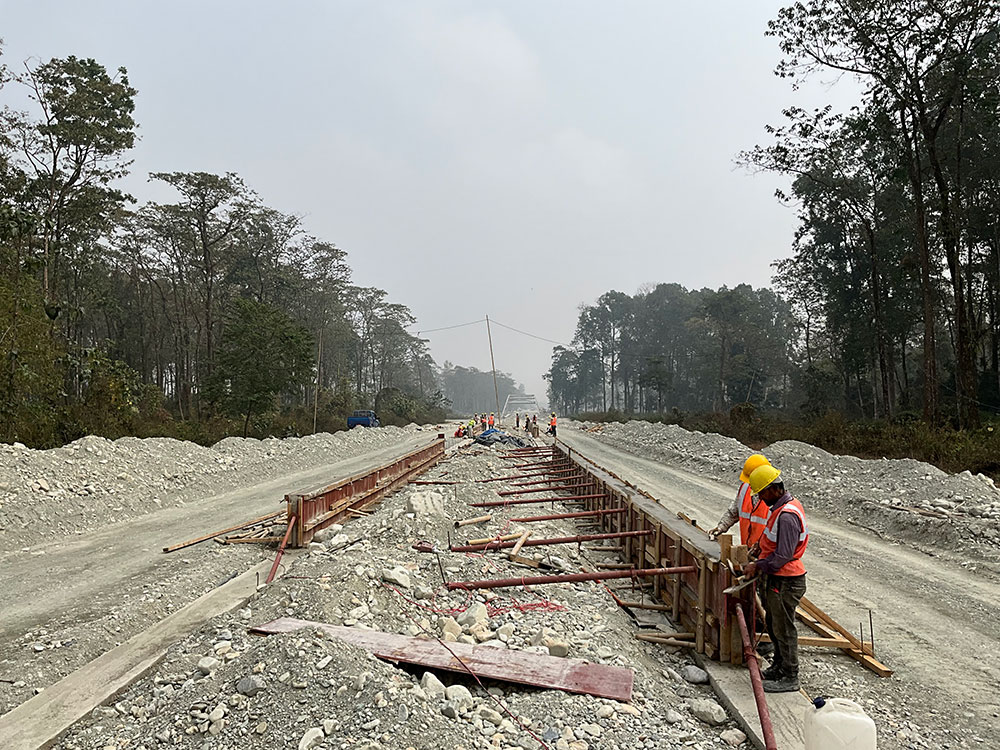Lhakpa Quendren
Gelephu—The urban corridor development along the Gelephu-Sarpang highway will transform the Gelephu Special Administrative Region (GeSAR) into a vibrant and visually stunning hub once completed.
Development for the remaining work started in February with the aim to finalise the urban corridor road network by the end of May this year.
Currently, construction is in progress for a 175-centimeter-long concrete shuttering for a 5-meter-wide road divider.
The plans to enhance amenities, including blacktopping, along this 2.65 km road from the fuel station to the airport, covering the Gelephu dry port, were halted due to financial constraints following the road’s completion in 2020.
As part of the construction package, only a 100-meter stretch of the road adjacent to the bridge was blacktopped. Consequently, traffic has been diverted to an alternative bypass near a stream, located 1.5 km from Gelephu town along the old road.
However, this bypass remains impassable during the monsoon season, posing challenges for commuters.
The urban corridor features a spacious 30-meter right-of-way, extending four meters on each side of the median. Crafted with precision using top-notch Japanese technology, this infrastructure meets international standards for quality, promising durability and safety for all commuters.
The Gelephu Thromde Administration has prioritized the project, recognising the significance of the Gelephu Mindfulness City Project. This decision stems from the growing influx of high-profile visitors, including international experts and potential investors.
Gelephu Thrompon Tshering Norbu said that there is a critical need to improve the urban corridor. “During the monsoon, the road becomes muddy and impassable for vehicles, posing safety hazards and inconvenience to commuters.”
He explained that as the second airport in the country, the project is essential for providing travelers with an aesthetically pleasing environment. “This reflects the country’s commitment to hospitality and excellence in infrastructure.”
Tshering Norbu further added that the project design underwent rigorous scrutiny to align with expected major development plans, particularly concerning traffic loads and infrastructure standards.
“Special attention was paid to align the project specifications with the standards at par with the Primary National Highway capacity,” he said.
Recognising the importance of accommodating future growth, he said, the project specifications were meticulously reviewed to ensure scalability and adaptability to potential developments.
This proactive approach ensures that the infrastructure remains capable of meeting evolving needs and demands in the years to come.
Acknowledging that urban category primary roads traditionally have lower capacity than national primary highways, the project design was specifically tailored to exceed these standards.
This is to ensure adequate support for the region’s evolving transportation demands and expected growth trends, ensuring seamless connectivity and mobility for all.
The median will be adorned with aesthetically pleasing street lighting infrastructure, strategically positioned at the center to enhance visibility at night and improve the corridor’s ambiance.
Additionally, natural landscaping elements will also be integrated into the median to enhance beauty and promote environmental sustainability.
Aligned with the structural plan of 2005, once completed, this corridor will emerge as the paramount artery from the Gelephu International Airport to the throm, cementing its position as the primary gateway for all visitors
This strategic infrastructure investment ensures seamless connectivity and accessibility, further enhancing the region’s appeal as a key destination.
The project, funded by the Royal Government of Bhutan with a total budget of Nu 34.273 million, is being executed by Tob-den Construction Company for infrastructure and development. About 20 workers have been employed in the development of this project.


